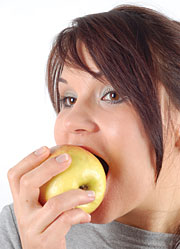Tips for Teens with Diabetes: Stay at a Healthy Weight
Download This Publication (NDEP-65)
Want this item now? Download it here:
Print this Publication (NDEP-65)
To print large quantities of a publication, you can order printer-ready files for $20 each by calling 1-800-860-8747.
Order this Publication (NDEP-65)
To order a copy of this publication, select quantity and "add to cart".
- Hide order info
-
Single copies up to 10 copies, free. Each additional package of 10, $2. Limit 100 copies (10 packages).

This tip sheet provides useful information about diabetes and encourages teens to take action to manage their disease for a long and healthy life.
Last reviewed: 11/01/2012
Why is it good to be at a healthy weight?

Staying at a healthy weight as a teen may help you control your weight for life. Being at a healthy weight helps you feel fit, stay well, and feel good about the way you look. It can also help prevent health problems like heart disease and high blood pressure. If you have diabetes and are overweight, weight loss may improve your blood glucose, also called blood sugar, and make your diabetes easier to manage.
How can I get to a healthy weight?
If your doctor says that you should not gain more weight or that you should lose weight, you need to get more physical activity every day and eat fewer calories. Ask a dietitian or diabetes educator to:
help you decide what kinds of activities might fit into your busy life as a teen
help you and your family create a well-balanced meal plan and make healthy food choices
Here are some things to try
1. Be active every day for at least 60 minutes.This will help you burn up extra calories and get fit. Invite some friends over to dance to your favorite music. Play a sport or go for a bike ride instead of playing computer games or going to the movies. Ask a friend or family member to join you on a walk instead of watching TV after school.
2. Cut some calories. The number of calories shows how much energy a food supplies. Calories that are not used up are stored as body fat. Calories are listed on food labels. Get in the habit of reading food labels. If you cut 100 to 200 calories a day, it can make a big difference.
| If you: | You could cut about: |
|---|---|
| Drink water instead of regular soda or a sweetened fruit drink | 150 calories |
| Eat a piece of fruit instead of a candy bar or a bag of chips | 200 calories |
| Eat a small serving of french fries or share a big one | 250 calories |
| Eat one half cup of sugar-free, nonfat pudding instead of regular ice cream | 150 calories |
3. Eat smaller amounts of food for meals and snacks. Try raw vegetables or fruit for a snack. To avoid “grazing,” measure out your snacks for the day into baggies that are easy to carry.
If you eat less and are more physically active, you should lose about one or two pounds a month—and feel great. It is best to lose weight a little at a time because you are still growing. If you lose weight slowly, you are more likely to keep it off.
What are some healthy eating tips I can try?

Take your time when you eat. It takes about 15 minutes for your stomach to tell your brain that you are full. So… wait 15 minutes before eating second helpings.
Ask if you can help plan, make, or shop for the family meals sometimes.
Drink a glass of water before you eat.
Fill up half of your plate with salad or vegetables. Use small amounts of low-fat salad dressing, mayonnaise, or margarine.
If you like to eat sugary foods, sweets, desserts, or candy, eat only a small serving at the end of a meal and not every day… then take an extra walk. The less you eat them, the less you may crave them!
Very low-calorie diets are not healthy for teens.
If you do not eat enough of the right kinds of food, you may not grow or develop properly. Never make a drastic change in what you eat without talking with your dietitian or doctor. They can help you determine the right amounts of food to keep you healthy and happy.
What about breakfast?
Breakfast is a great way to start your day. It will help you focus and pay attention in school throughout the day.
Have one bowl of whole grain cereal with nonfat or low-fat milk or yogurt and a piece of fruit.
When you do not have much time, try a couple of whole grain crackers or slices of bread with a tablespoon of natural peanut butter, a hard-boiled egg, or a piece of low-fat cheese, along with a glass of nonfat or low-fat milk.
What about school lunches?

If you buy your lunch at school, try to steer clear of fried foods. Choose:
small deli sandwiches or subs made with lean turkey, chicken without the skin, or beef with mustard or a little low-fat mayonnaise
nonfat or low-fat milk instead of chocolate milk
a piece of fresh fruit instead of cookies or cake
If there is a salad bar, choose a variety of fresh vegetables and fruits. Use a small amount of low-calorie dressing.
Pack lunch at home the night before to save time.
Use leftovers from dinner.
Make a tuna sandwich.
Add raw carrots and a piece of fruit.
Can I still have a snack?
Most teens need a snack after school. The trick is not eating too much. Use a small plate or bowl for your snack to help you control the portion size. It is best not to snack while watching TV or at the computer—it is easy to lose track and eat too much.

Here are some healthy snack ideas:
A piece of fresh fruit.
A cup of veggies served with some salsa or a little low-fat salad dressing.
A small bowl of whole grain cereal with nonfat or low-fat milk.
A small bowl of vegetable soup and a few crackers.
One small tortilla with one or two slices of low-fat cheese or turkey.
Three cups of low-fat microwave popcorn or a single serving bag.
One handful of pretzels or crackers.
Drink a couple of glasses of water with your snack.
Can I eat at fast-food restaurants?
Sure, but not every day. When you do, try these ideas:
- Don’t “super-size” it! Order smaller, kid-sized meals and drink water or nonfat or low-fat milk. Share a larger meal with a friend.
- Choose a grilled chicken sandwich or a simple hamburger rather than a burger covered with sauce, cheese, and bacon. Add a small baked potato with a little butter or sour cream or a small serving of fries.
- If you are eating pizza, order thin or medium crust instead of deep dish or stuffed crust. Eat only one or two slices of plain cheese or vegetable pizza. Add a salad with a little low-fat dressing.
- Try a small bag or a handful of baked chips or pretzels instead of regular chips.
Reaching and staying at a healthy weight while you are a teen helps you stay fit as you get older. Encourage family members and friends to get fit too by making healthy food choices and joining you in physical activity.
Application Required
PDF files require the
free Adobe Acrobat Reader![]() application for viewing.
application for viewing.
WMV is Video file in Windows Media Player format. Download the free Windows Media Player![]() application for viewing.
application for viewing.
MP3 is Music file. Download the free Windows Media Player![]() application for viewing.
application for viewing.
All our publications are copyright-free. Please duplicate and distribute as many copies of these materials as desired. Online information may be more recently updated than printed materials.
Attention visually impaired visitors: To use common screen
reading programs with PDF documents, please visit Accessibly Resource Center![]() , which provides a set of free tools that convert PDF
documents to simple HTML or ASCII text.
, which provides a set of free tools that convert PDF
documents to simple HTML or ASCII text.
